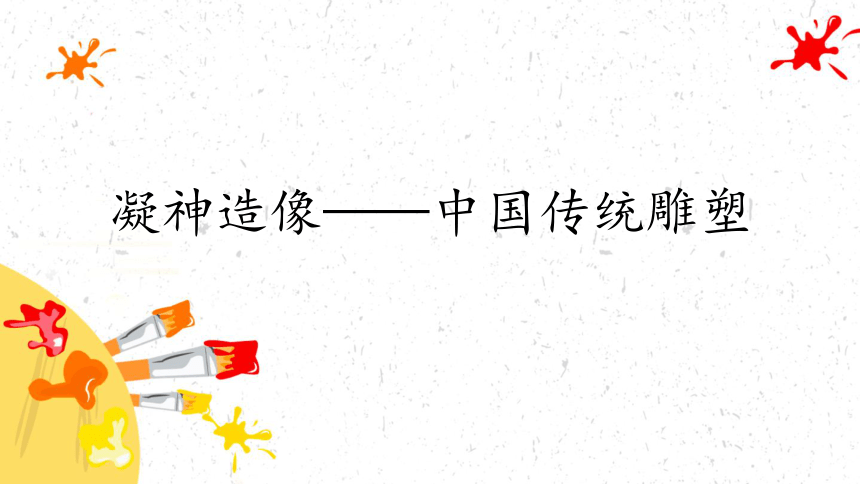(
课件网) 凝神造像———中国传统雕塑 基本问题 中国传统雕塑承载了古代中国人怎样的文化观念? 情境导入 1987年,泰始皇陵及兵马俑被联合国教科文组织列入《世界遗产名录》,是中国首批列入《世界遗产名录》的六处遗产之一。如何认识和理解这一重要的文化遗产?从中能看出中国传统雕塑有哪些特点?中国传统雕塑还有哪些化秀的代表作品? 学习目标 1.认知不同类型传统雕塑具有不同的艺术特点; 2.能够运用雕塑相关术语联系人文历史等知识鉴赏雕塑作品; 3.通过对传统雕塑的学习,增强爱国情感,尊重文化的差异性和多样性。 一、中国雕塑发展简述 中国雕塑艺术肇始于新石器时代,历先秦三代,经秦汉、南北朝的发展,至隋唐达到鼎盛。 二、 传统雕塑的分类 材质———陶塑、石雕和泥塑等。 功能用�———陵墓雕塑和宗教雕塑。 1、 Brief introduction to the development of Chinese sculpture Chinese sculpture art began in the Neolithic age and reached its peak in the Sui and Tang Dynasties through the development of the Qin and Han Dynasties and the northern and Southern Dynasties. 2、 Classification of traditional sculpture Material - pottery sculpture, stone carving, clay sculpture, etc. Functional use - tomb sculpture and religious sculpture. 陵墓雕塑 陵墓雕塑是中国古代雕塑艺术的重要组成部分,是中国古代厚葬流行的产物,并集中体现了特定历史时代的社会理想、审美形式和高超的艺术水平。 中国古代陵墓雕刻艺术以寓意象征的手法表达特定的主题,雕刻技巧独特,整体造型稳定而强劲,形成了中国古代雕刻艺术独特的民族风格。 The mausoleum sculptures The ancient Chinese mausoleum carving art expresses the specific theme by means of implication and symbol, the carving technique is unique, the overall shape is stable and strong, and forms the unique national style of the ancient Chinese carving art. 一、陵墓雕塑 古代中国人相信人死后灵魂不灭,形成了特定的丧葬观念,所以中国古代陵墓的地下,地上设施和随葬品都要模仿墓主人生前生活的场景。 Ancient Chinese believed that people's soul would not die after death, forming a specific concept of funeral. Therefore, the underground, aboveground facilities and funerary objects of ancient Chinese tombs should imitate the scenes of the tomb owner's life before his death. (一)秦始皇陵兵马俑 根据《史记》记载,秦始皇陵是按照秦朝都城的格局设计建造的,陵墓内部“上具天文,下具地理”,俨然构成了一个死后的世界,数量庞大,气势恢宏的兵马俑,就是守护这座都城的地下军队。 秦始皇陵一号兵马俑坑 The Terracotta Warriors and Horses in the Mausoleum of Emperor Qin Shihuang 秦皇陵兵马俑群俑图片欣赏 秦始皇陵兵马俑佣阵随葬陶制佣人数多达8000余件,个个身形高大,平均身高185cm,排练整齐,井然有序,显示出秦国的军威。 铜制车马按真实的车马1:2的比例塑造,造型精美,装饰华丽,结构和系驾逼真、完整。 这几件陶俑以不同的衣饰、动态显示了不同的身份和地位、兵种。 欣赏各种类别俑图片 有些陶俑出土时绘上鲜明的色彩,每个陶俑五官和头饰的刻画细致入微,面貌不同,年龄、神态各异,写实性极强。 这些陶俑制作时用了什么样的手法? Some of the pottery figures were painted with bright colors when they were unearthed. The facial features and headwear of each pottery figure are described in detail, with ... ...

